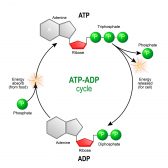Table of Contents
Definition
noun
plural: adenosine diphosphates
(biochemistry) A nucleotide made up of adenine, ribose, and two phosphate units; having a chemical formula: C10H15N5O10P2; the product of ATP de-phosphorylation via ATPases to release energy; and can be converted to ATP by phosphorylation (addition of phosphate and energy) via ATP synthases to store energy
Details
Overview
A nucleotide is an organic compound made up of three subunits: a nucleobase, a five-carbon sugar, and a phosphate group. The sugar component may either be ribose or deoxyribose. A nucleotide is, thus, a nucleoside with a phosphate group. Depending on the number of phosphate groups attached to the sugar moiety, a nucleotide may be called nucleoside monophosphate (if with only one phosphate group), nucleoside diphosphate (with two phosphate groups), or nucleoside triphosphate (when with three phosphate groups).
Depending on the pentose sugar component, a nucleoside may be a ribonucleoside or a deoxyribonucleoside. A ribonucleoside is a nucleoside with a ribose sugar component. Based on the nucleobase component, the ribonucleoside may be adenosine, guanosine, cytidine, uridine, or 5-methyluridine. A deoxyribonucleoside is a nucleoside with a deoxyribose sugar. Similarly, depending on the nucleobase component, a deoxyribonucleoside may be deoxyadenosine, deoxyguanosine, deoxycytidine, thymidine, or deoxyuridine. Also, depending on the nucleobase component, the nucleosides may be grouped into either the “double-ringed” purine or the “single-ringed” pyrimidine.
Structure
Adenosine diphosphate (ADP) is a nucleoside phosphate comprised of a ribonucleoside and two phosphate groups. It means it has a ribose as its sugar and two phosphate groups attached. Its nucleoside contains a purine base, i.e. an adenine attached to the ribose sugar. It has two phosphate groups attached to the nucleoside. The nucleoside is a pentose sugar backbone with a purine base adenine attached to it (at the 1′ carbon). The phosphate groups are bonded in series to the 5′ carbon of the pentose sugar.
Common biological reactions
Common biological reactions
ADP can be derived from adenosine triphosphate (ATP). It can be interconverted to ATP. In particular, ATP is dephosphorylated by ATPases to produce ADP. ADP in turn may be phosphorylated to become ATP. In plants, this conversion of ADP into ATP is enabled via photosynthetic pathways, as light energy is stored as chemical energy in ATP. In animals, energy can be drawn from the breakdown of foodstuff. Glucose from dietary sources, in essence, is used to gather energy via glycolysis, aerobic respiration, and fermentation. The energy is stored especially in the form of ATP. The breakdown of one phosphory bond of ATP can generate about 30.5 kilojoules per mole of ATP.1
ADP can be degraded to produce adenosine monophosphate (AMP, an adenine nucleotide with only one phosphate). Combining two molecules of ADP during ATP synthesis by the action of the enzyme adenylate kinase leads to the formation of AMP: 2 ADP → ATP + AMP.
Biological functions
ADP is essential in photosynthesis and glycolysis. It is the end-product when adenosine triphosphate ATP loses one of its phosphate groups. The energy released in the process is used to power up many vital cellular processes. ADP reconverts to ATP by the addition of a phosphate group to ADP. This occurs in processes such as substrate-level phosphorylation, oxidative phosphorylation, and photophosphorylation.
ADP is also important during the activation of platelets. It is stored inside the platelet and is released to interact with ADP receptors (e.g. P2Y1 receptors, P2Y12 receptors, etc.) on platelets.
Supplementary
Abbreviation(s)
- ADP
IUPAC
- (2R,3S,4R,5R)-5-(6-Aminopurin-9-yl)-3,4-dihydroxyoxolan-2-ylmethyl phosphono hydrogen phosphate
Chemical formula
- C10H15N5O10P2
Also called
- adenosine pyrophosphate
- adenosine 5′-diphosphate
- adenosine 5′-pyrophosphate
- adenosine pyrophosphate
Further reading
See also
Reference
- Farabee, M.J. (2002). “The Nature of ATP”. ATP and Biological Energy on the Internet. Archived from the original on 2007-12-01.
© Biology Online. Content provided and moderated by Biology Online Editors

